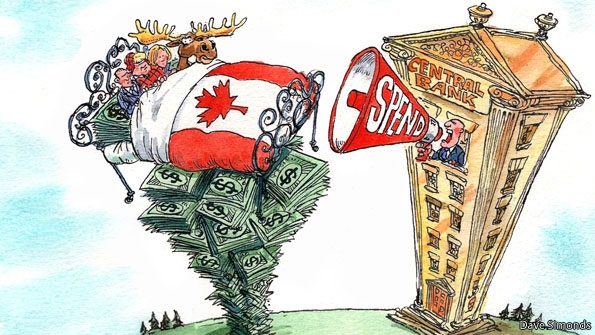
加拿大执政的保守党喜欢夸耀自己的国家经受住了全球经济衰退的考验,比七国集团的其他成员更经得起考验。尽管他们往往将此归功于自己的英明政策,其中主要原因之一就是加拿大保守党的企业文化。加拿大银行刚刚涉足次级抵押贷款的时候,美国的住房市场就崩盘了。
美国住房市场崩盘被普遍视为金融危机期间的一个很受用的警示,现在看来一场没有把握的的经济复苏就是在冒令人窒息的风险。加拿大在2010年和2011年的GDP平均每年增长2.8%,超过美国和其它对大宗商品依赖的发达经济体国家如澳大利亚、新西兰和挪威。经合组织现在预测它将在2012年增长1.9%,这就同新西兰国家经济状况一样并且低于其他三个国家。
这种经济放缓的部分原因是由于加拿大资源出口价格低,欧洲和强势货币对商品需求疲软。但国内因素也起到了推波助澜的作用。
首先,政府在2009年发起了一项刺激计划以支撑经济。在2010年12月其赤字平均占GDP的5.1%。现在正在紧缩开支。总理斯蒂芬•哈珀(Stephen Harper)已承诺单靠削减开支的方式到2015年就会缩小这一差距。2012年总公共支出预计为5%低于2009年时的峰值水平。
与此同时,消费者支出一直在受房地产热潮刺激,常被比作美国危机前的房地产泡沫。两年以来,央行把基准利率保持在1%,鼓励加拿大人借贷,尤其鼓励抵押贷款。多伦多的房价去年就上升了8.3%。央行行长马克·卡尼就这些日益增长的债务再三发出警告。消费者借贷和支出能力可能正在接近极限。
借贷成为企业持续增长的最后潜在来源。不幸的是,他们倾向积累应急基金,这只能暂时稳定一下经济衰退波动形势。他们的现金储备目前相当于国内生产总值的30%,是历史平均水平的三倍。他们没有完全停止投资,在2009年,私人部门的非住宅投资在下降了21%以后已基本恢复——但是他们的支出还远不足以弥补消费下降费用和政府支出费用。
此外,加拿大的私人投资均匀分配在机械和设备上,大幅提高生产率、存储和运输货物这一结构其影响作用很小。在美国生产结构占的份额要小得多。这种差异可能是由于加拿大对自然资源的依赖如石油,这就要求要有石油管道。但这意味着这个国家的投资收益减少而产量收益要比南部边境地区的多。
政府在极力说服公司投资。卡尼(Carney)已要求他们开始花他们的“定期存款”,这还多亏了定期存款低利率低收益这一点。“公司的工作就是让钱去工作,”他最近是这么说的,“如果公司想不出应该让钱去做什么样的工作的话,那他们就应该把钱还给股东。”财政部长吉姆•费海提(Jim Flaherty),他在上个月提醒高管们的时候,听起来很是忧心发愁,政府已降低税率,减少繁琐程序并通过增加税收优惠政策鼓励他们投资。“最终,这就取决于私营部门利用这一切优势来进行投资、创造就业、发展我们的经济,”他说。但是现在看来他们似乎都在充耳不闻。迈克尔·霍尔登(Michael Holden),是加拿大西部基金会的一位经济学家(智囊团称敦促公司加快行动就像“在堵车的时候,向堵在前面的车按喇叭是一个道理。”
政府不单单就只坚持以德服人的原则。政府努力签署了加倍量的贸易与投资协议,来多元化扩大加拿大出口增长缓慢的市场,其中有85%的市场现在尚处于引导阶段,引导市场转向充满活力的亚洲经济体。上个月加拿大和中国签署了一项投资保护协定。
官员们还可以推动教育改革,鼓励学校来培训比较有胆识的高管们,尽管到目前为止还未优先考虑这一点。比尔·柯里(Bill Currie),在德勤会计事务所的一个咨询机构工作,他说加拿大要想通过大学课程为企业和工程培养出比较敢冒风险、心胸比较开阔的和比较有创造力的人才,那么从中学开始就得教经济学。但是卡尼(Carney)和弗莱赫蒂(Flaherty)要想在不久的将来就看到这些项目开花结果。那么现在一流的讲台就是他们的一切。
CANADA’S ruling Conservatives like to boast that their country weathered the world recession better than any other G7 member. Though they tend to attribute this success to their own policies, one of the main causes was Canada’s conservative corporate culture. Its banks had barely dabbled in subprime mortgages when America’s housing market imploded.
That caution, widely seen as a virtue during the financial crisis, now looks problematic in a recovery that is at risk of choking. In 2010 and 2011 Canada’s GDP grew by an average of 2.8% a year, more than America’s and than the economies of other rich commodity-dependent countries like Australia, New Zealand and Norway. The OECD now predicts it will grow by 1.9% in 2012, the same as New Zealand and less than the other three countries.
This slowdown is partly owing to lower prices for Canada’s resource exports, weak demand for its goods from Europe and a strong currency. But home-grown factors have also played a part.
First, the government launched a stimulus programme in 2009 to prop up the economy. In 2010-12 its deficit averaged 5.1% of GDP. It is now retrenching. Stephen Harper, the prime minister, has promised to close the gap by 2015 via spending cuts alone. Total public expenditure in 2012 is forecast to be 5% below its 2009 peak.
Meanwhile, consumer spending has been spurred by a housing boom that is often compared to America’s pre-crisis bubble. The central bank has kept its benchmark interest rate at 1% for two years, encouraging Canadians to pile up debt, particularly in mortgages. In Toronto house prices have risen by 8.3% in the past year. Mark Carney, the bank’s governor, has issued repeated warnings about these growing liabilities. Consumers’ ability to borrow and spend may be nearing its limit.
That leaves businesses as the last potential source of continued growth. Unfortunately, their penchant for accumulating rainy-day funds was only reinforced by the tumult of the recession. Their cash hoards now amount to 30% of GDP, three times the historical average. They have not stopped investing altogether—private-sector non-residential investment has almost recovered after falling by 21% in 2009—but they are not spending nearly enough to compensate for declining consumption and government outlays.
Moreover, Canadian private investment is divided evenly between machinery and equipment, which boost productivity sharply, and structures that store and transport goods, which have less of an impact. In the United States structures account for a far smaller share. This discrepancy may simply be a result of Canada’s dependence on natural resources such as oil, which requires pipelines. But it means that the country’s investments yield fewer gains in productivity than those south of the border do.
The government is doing its best to talk firms into investing. Mr Carney has demanded they start spending their “dead money”, which earns little interest thanks to his low rates. “Their job is to put money to work,” he said recently, “and if they can’t think of what to do with it they should give it back to their shareholders.” Jim Flaherty, the finance minister, sounded almost plaintive when he reminded a group of executives last month that the government had reduced tax rates, cut red tape and increased tax incentives to encourage them to invest. “Ultimately, it is up to you in the private sector to take advantage of all of these strengths and to invest, to create jobs and to grow our economy,” he said. For now, however, their entreaties seem to be falling on deaf ears. Michael Holden, an economist at the Canada West Foundation, a think-tank, says that urging firms to move faster was like “people who honk at the car in front of them in a traffic jam”.
The government is not relying on moral suasion alone. It has redoubled efforts to sign trade and investment deals to diversify Canadian exports away from slow-growth markets, where 85% of them are now directed, and towards racy Asian economies. Last month Canada and China signed an investment-protection pact.
Officials could also push education reform to encourage schools to train bolder executives, though that has not been a priority so far. Bill Currie of Deloitte, a consultancy, says Canada could produce managers more comfortable with risk by making university courses for businesses and engineers broader and more creative, and by teaching more economics in secondary school. But Mr Carney and Mr Flaherty will be long gone by the time such projects bear fruit. Just now the bully pulpit is all they have got.

